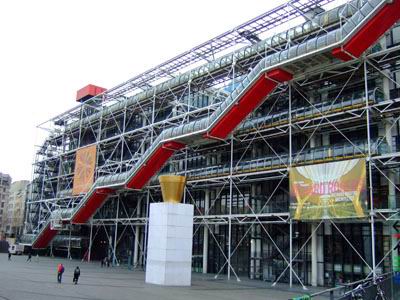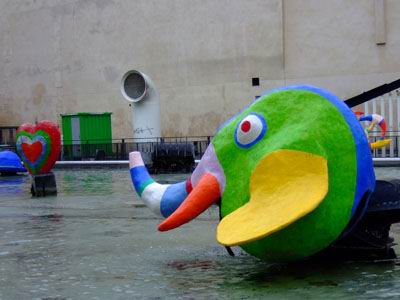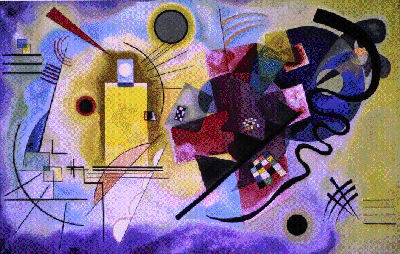- Home
- Itinerary
- Museums
- Museums
- Monuments
- Monuments
- Quartiers
- Quartiers
- Shows
- Shows
- Food
- Food
- Explorations
- Explorations
- Projects
- Projects
- People
- People
- Gallery
- Gallery
- About
- About
- Home
- Home
Le Centre Georges Pompidou (Beaubourg): Musée National d’Art Moderne
Amidst an area of pleasant cafés, brasseries, shops, a gothic church, and the Stravinsky fountain, the Centre Pompidou rises up as a modern landmark of the Beaubourg area of the 4ème arrondissement (Métro: Rambuteau). In 1977, this building “turned the architectural world upside down,” or rather “inside-out,” with its color-coded electrical, air, and water tubes, escalators and elevators, and other typical “building innards” on full display along the outside of the building, leaving a large space within for a two-story art gallery, music library, public library, café, shop, performance space, and cinema, among other things.

The Centre Pompidou contains Europe's largest collection of modern and contemporary art, rivaled only in its breadth and quality by MOMA in New York. Within you can find a large selection of pieces including those by major modernist and contemporary artists like Matisse, Picasso, Kandinsky, Dali, Man Ray, and Dubuffet. Generally for contemporary art, you either hate it or love it. This time around, I left the building feeling mostly bewildered by the large collection of sculptures/paintings/installations/things that made me think what the…?/miscellaneous media that I saw. (-Carmel)

Fanciful sculptures outside the museum.
I’ve never been much of a fan of modern art. I’ll admit there are some beautiful works of modern art. However, I did not appreciate any of the Matisse paintings I saw. The guide pointed out the recurring themes of windows, but I found Matisse’s windows terribly sad in their oversimplification of the Parisian architecture. They seemed to reflect a jaded view of his own city, portrayed by an artist no longer capable of appreciating the aesthetics of the city that wowed me each day I was there. Next we saw something white and porcelain looking suspiciously like a urinal placed on its side. In fact, it was just that! The only modification was a small signature on the side. It’s hard to appreciate something that only required the “artist” to have enough money to purchase a urinal (or the time and energy to steal one) and the capability to write his name. Next we spent several minutes staring at an empty frame with four strings, three words, and another “artist’s” name (Picabia). It didn’t quite reach the level of masterpiece, especially after visiting the Louvre and admiring works of art which obviously took years of work and an incredible talent. If I were an artist from that era and I were capable of seeing the works that can earn their way into art museums today, I think I would be insulted. We spent about ten minutes in front of “Portrait d’une danseuse” by Joan Miro. This particular work showed a great aptitude in placing thumb tacks in a wall, and also in balancing a feather between thumb tacks. After a long lecture, I understood what these two thumbtacks + feather + string were trying to tell me, but I believe that any artwork which takes more time to interpret than to reproduce is hardly respectable. I saw many phallic symbols and other sexually explicit works, none of which I would have recognized as such without our guide. If you do ever make it to this museum, be sure to check out the works by Vassily Kandinsky.

Kandinsky painting.
At least this modern artist’s work shows a level of complexity and beauty that doesn’t make me feel as though they were made in under five minutes. (-Emilienne)